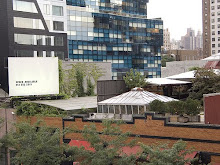

1) 1157 Wheeler Ave, previous home of Amadou. 2009, Mike Ren. 2) Mural on Wheeler Ave. 2009, Mike Ren. 3) Banner on mural on Wheeler Ave. 2009, Mike Ren.
The story of Amadou Diallo and his death is a leading example of the practice of racial profiling. The disproportionate numbers of stops and arrests of people of color by police is an issue that still plagues our nation today, and this example is one of the most famous and overt displays of the paradoxical injustice of our justice system.
On February 4, 1999, just after midnight, police officers Ed McMellon and Sean Carroll noted Amadou Diallo, a 22-year-old West African immigrant, outside on the stoop of his Bronx house. After being joined by officers Kenneth Boss and Richard Murphy, the officers pursued Diallo. Having received a report of a dark-skinned rapist in the area, the officers suspected that Diallo could be the perpetrator. The officers called out to their suspect – upon hearing the policemen, Diallo turned around and reached into his back pocket to retrieve a small, black object. Immediately assuming the object to be a gun, the police officers open-fired on Diallo, shooting 41 bullets, 19 of which pierced their target. After they lowered their weapons and approached Diallo’s dead body, they realized that the object Diallo had reached for had not been a gun – it had been his wallet.
There is no official commemoration at Amadou’s house or on his street in the Bronx. The only reminder of the incident is a 15 to 20 foot mural that depicts Diallo with images of the Statue of Liberty as a skeleton and the American flag in the background, along with the words “American Dream” written across the top. This community response to the shooting expresses the position that there are contradictions between what America claims to stand for (freedom, democracy, etc.) and what racial biases actually exist.
Were the policemen, all of whom were white, predisposed to assume that because of Amadou’s black skin, he was the criminal they were searching for? In investigating all types of police intervention, Amnesty International predicts that blacks are victims of racial profiling 47% of the time, while whites experience racial profiling 3% of the time[1]. Another study concludes that even though 71.3% of whites abuse drugs, 5.7% are arrested; in contrast, 17.7% of blacks abuse drugs, yet 84.2% are arrested[2]. A study conducted by the Department of Justice found that police disproportionately targeted Blacks and Latinos[3]. In 2006, the NYPD investigated 500,000 individuals upon suspicion of criminal involvement, 89% of which were non-white[4]. In spite of many things: Amadou’s lack of criminal record and firearm; bullet holes found in Amadou’s feet, signifying that he was shot after he was down; and numerous peaceful protests by citizens around the nation, all four officers were acquitted of all charges. This demonstrates that racial biases and discriminations still exist in government-supported institutions.
Bibliography:
1. Amnesty International: USA: California: Update on Police Brutality.
2."Analysis of the Disparities In the New York City Police Department's Stop, Question, and Frisk Practices." Racial Profiling Data Collection Resource Center. North Eastern University. Web.
3. Cotts, Cynthia. "Deconstructing Diallo's Death." The Village Voice [New York] 2 Mar. 1999. Print.
4. Roy, Beth. 41 Shots...And Counting:What Amadou DIallo's Story Teachers us about Policing, Race, and Justice. Syracuse: Syracuse UP, 2009. Print.
5. Threat and Humiliation: Racial Profiling, National Security, and Human Rights in the
6. "Racial Profiling - The Truth About Racial Profiling: Seven Facts." Amnesty International USA. Amnesty International. Web.
[1] Threat and Humiliation: Racial Profiling, National Security, and Human Rights in the United States. Rep. New York: Amnesty International USA Pulbications, 2004. Http://www.amnestyusa.org. Amnesty International. Web. P. 1
[2] Threat and Humiliation, p. 22
[3] "Racial Profiling - The Truth About Racial Profiling: Seven Facts." Amnesty International USA. Amnesty International. Web.
[4] ."Analysis of the Disparities In the New York City Police Department's Stop, Question, and Frisk Practices." Racial Profiling Data Collection Resource Center. North Eastern University. Web.


No comments:
Post a Comment